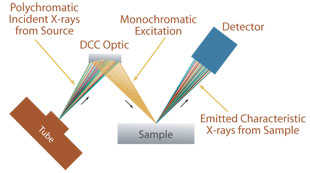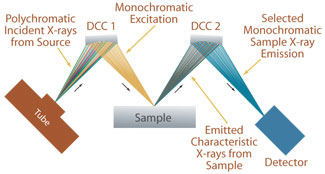- Analyzers
- Optics & Sources
- Technologies
- Support
- About
Monochromatic Micro X-ray Fluorescence (MµXRF)
Micro X-ray fluorescence (µXRF) is an elemental analysis technique which allows for the examination of very small sample areas (typically 10s to 100s of micrometers in diameter) using a monochromatic ray. X-ray optics can be used to enhance µXRF applications by capturing X-rays from a divergent source over a large angle and to redirect them to an intense, focused beam on the sample surface. Monochromatic µXRF (or MµXRF) is facilitated by doubly curved crystal optics, which direct an intense micron-sized monochromatic X-ray beam to the sample surface for enhanced elemental analysis. MµXRF provides several advantages over µXRF techniques using polychromatic excitation for some applications, including larger working distances and simpler quantitative analysis. More importantly, monochromatic excitation eliminates the X-ray scattering background under the fluorescence peaks and therefore gives very high sensitivity. Typical detection limits at ppb levels for bulk contaminants or femtogram levels can be achieved with this technique.
MµXRF can be achieved using DCC optics for both EDXRF and WDXRF geometries.


Monochromatic WDXRF using doubly curved crystal optics has the advantage of very high sensitivity for a specific sample element of interest. This technique has been successfully used for measurement of low levels of sulfur in petroleum products.

